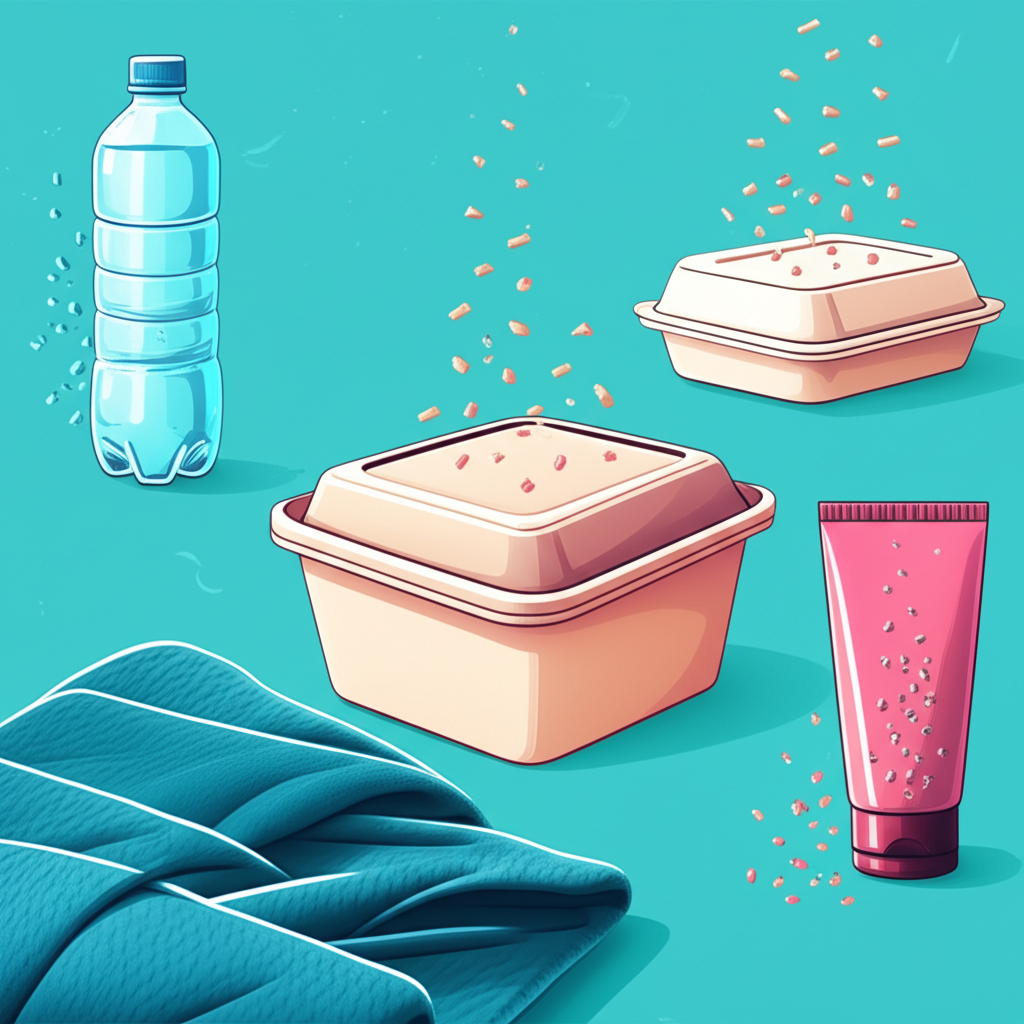Imagine tiny plastic fragments everywhere. These fragments are in the air you breathe, the water you drink, and the food you eat. This might sound like science fiction; however, it is our reality. Studies suggest that an average person consumes about 5 grams of plastic each week. This amount is roughly the weight of a credit card. Indeed, various sources confirm this alarming fact. Consequently, it highlights plastic pollution’s pervasive nature. For more insights into plastic pollution, explore reports from organizations like the World Wide Fund For Nature (WWF).
This invisible invasion of microplastics poses a growing concern. Scientists and public health experts are particularly worried. These tiny particles, often unseen, have found their way deep into our bodies. Thus, they are not just in the environment; they are within us.
This article explores the surprising and often overlooked ways microplastics enter our bodies daily. We will uncover diverse pathways. For example, they come from our drinking water and seafood. Additionally, we inhale them from the air. Even the food we prepare contains them. Let us delve into this critical issue.
What Exactly Are Microplastics?
Microplastics are incredibly small plastic pieces. Specifically, they measure less than 5 millimeters across. This size is smaller than a grain of rice. These tiny fragments come from larger plastic items that break down. Furthermore, they originate from products already designed to be small.
Scientists categorize microplastics into two main types based on their origin:
| Type of Microplastic | Definition | Examples |
|---|---|---|
| Primary Microplastics: | These plastics are originally manufactured at a small size. | Microbeads appeared in some older personal care products, though most are now banned. Plastic pellets, also called nurdles, are used in manufacturing. Additionally, synthetic fibers from clothing, such as polyester or nylon, are primary microplastics. |
| Secondary Microplastics: | These form when larger plastic items break down. | They include pieces from plastic bottles, bags, fishing nets, and car tires. Consequently, sunlight, waves, and wind cause this breakdown. |
Microplastics do not biodegrade easily. Therefore, they do not break down naturally into harmless substances. Their tough composition allows them to persist for hundreds, even thousands of years. This durability helps them travel widely across oceans, land, and even the atmosphere. Indeed, they become global travelers.
The Invisible Invaders: Size and Detection Challenges
Microplastics’ microscopic nature makes them hard to spot. You cannot see them with your naked eye. Consequently, this invisibility makes avoidance incredibly difficult. Often, we simply do not know they are there.
Their sheer volume is also staggering. Researchers estimate trillions of microplastic particles exist across our planet. Indeed, they contaminate oceans, lakes, rivers, soil, and the air. This vast quantity clearly shows how widespread the problem truly is. Therefore, we are truly living in a plastic-filled world.
The Aquatic Pathway: Water Systems
Microplastics constantly contaminate our planet’s water systems. They flow into them from many sources. For example, wastewater treatment plants often discharge microplastics. Industrial runoff also contributes. Agricultural runoff carries them from farms. Additionally, stormwater brings tire wear particles from roads. All these sources funnel plastics into our precious water.
Drinking Water: Tap and Bottled
We find microplastics in both tap water and bottled water. This can be surprising to many people, however.
- Tap Water: Microplastics enter municipal water supplies in various ways. Source water, like rivers or lakes, already contains them. Old plastic pipes in our homes or cities can shed tiny particles. Furthermore, filtration systems are sometimes not entirely effective at removing these minute invaders.
- Bottled Water: Bottled water can contain even higher concentrations of microplastics than tap water. These plastics can leach from the plastic bottles themselves, especially PET bottles. Moreover, they can also come from bottle caps. The bottling process itself may introduce particles. Consequently, when bottles sit in the heat, this leaching can increase.
Contaminated Seafood and Salt
Marine life constantly encounters microplastics in the oceans. Fish and shellfish frequently ingest these particles. For example, filter-feeders like mussels and oysters are especially vulnerable. They consume vast amounts of water. Along with the water, they take in microplastics. Ultimately, when humans eat these contaminated organisms, the microplastics transfer into our bodies.
Sea salt also presents a pathway. Sea salt comes directly from ocean water. Given the widespread ocean pollution, it is not surprising that sea salt often contains microplastic particles. Therefore, a common kitchen staple can contribute to our daily intake.
Airborne Microplastics: Inhalation
Microplastics do not just pollute water; they also become airborne. Tiny particles easily release into the atmosphere. Consequently, this makes them simple to inhale.
Household Dust and Synthetic Fabrics
Our homes are not immune from microplastic pollution. A large part of indoor dust consists of microplastic fibers. These fibers come from synthetic clothing. Materials like polyester, nylon, and acrylic constantly shed them. Similarly, carpets, upholstered furniture, and other textiles also release fibers.
Everyday activities increase our exposure. For instance, simple actions like walking across a carpet stir up dust. Cleaning your home can also release fibers. Moreover, even sitting on your couch can send tiny plastic particles into the air you breathe. We inhale these fibers with every breath indoors.
Outdoor Air Pollution
Outdoor air also contains significant amounts of microplastics. Several major contributors exist. For example, tire wear from cars is a huge source. People often overlook this. As tires rub on roads, they shed plastic particles. Agricultural plastics, like plastic mulches, break down in fields. Furthermore, plastic waste degradation releases particles into the wind. Building materials can also shed plastic dust.
These lightweight particles do not stay in one place. Instead, wind currents carry them long distances. This atmospheric transport spreads contamination globally. Thus, microplastics from one continent can travel to another.
Food and Packaging: A Direct Route
Microplastics often contaminate our food directly. This happens from packaging or during preparation. Indeed, we may not even realize it is occurring.
Food Preparation and Storage
Many kitchen items contribute to plastic transfer.
- Cutting Boards: Plastic cutting boards can shed microparticles into food. This happens especially when they are scratched. Consequently, this adds plastic to your meals.
- Containers and Utensils: Plastic food containers and utensils also shed particles. Heating them or using them abrasively increases this shedding. Specifically, microwaving food in plastic often speeds up the transfer.
- Packaging Interaction: Plastic wrap, bags, and containers directly transfer microplastics. This occurs during food storage. Heating food in plastic, such as in a microwave, can cause transfer. Even simple contact leads to transfer.
Processed Foods and Their Wrappings
Processed foods also face contamination. Food processing equipment, for instance, can introduce microplastics. Complex packaging materials also contribute. Multi-layered plastics and plastic-lined cardboard are key examples. These materials can shed particles into the food.
Studies confirm microplastics in various processed items. Researchers, for example, find them in ready meals, bread, and even baby formula. These findings often link back to the packaging and manufacturing processes.
Personal Care Products and Cosmetics
For years, some personal care products contained microbeads. These tiny plastic spheres were in exfoliating scrubs and toothpaste. Many regions have now banned them; however, legacy issues remain from past use.
Even today, other plastic ingredients exist in cosmetics. Glitter is one obvious example. Various polymer thickeners or film-formers also contain plastics. Furthermore, when we wash these products down drains, they contribute to environmental pollution. Ultimately, this leads to human exposure.
Unexpected Pathways
Some sources of microplastic exposure are less obvious. Many people, for example, might not even consider them. Yet, they contribute significantly to our daily intake.
Tea Bags and Coffee Pods
Many commercial tea bags contain plastic. They might use plastic mesh, for instance. Or, they have polypropylene components. When steeped in hot water, these tea bags can release billions of micro- and nanoplastic particles. Consequently, your relaxing cup of tea might come with a side of plastic.
Plastic coffee pods also present an issue. They leach microplastics during the high-pressure brewing process. Therefore, your morning coffee could also deliver unwanted plastic particles.

Car Tires and Road Dust
Car tires are a massive source of microplastic pollution. People often overlook this fact. The constant friction of car tires on roads generates a huge amount of tire wear particles. Indeed, these particles are a significant form of microplastic.
These tire particles settle as road dust. We can then inhale this dust. Alternatively, it washes into water systems. From water, it can enter the food chain. Consequently, our daily commutes contribute to our microplastic exposure.

What Happens Once Inside?
Understanding the long-term health effects of microplastics in the human body is an ongoing process. Scientists are actively researching this area. Indeed, it is a rapidly evolving field of study.
Current research confirms microplastics are indeed inside us. Studies have found them in human blood, lungs, and even the placenta. They also appear in other organs. This clearly proves human exposure is happening.
Scientists are exploring potential implications. For instance, these tiny particles could cause physical irritation. They might also lead to inflammation in tissues. Furthermore, plastics contain chemical additives. These include phthalates and BPA. These chemicals can leach out of the plastics into our bodily tissues. More research is crucial to fully understand the long-term health implications. Clearly, we need to establish clear causal links between microplastics and specific health problems.
Frequently Asked Questions (FAQs)
Q1: How small are microplastics?
A1: Microplastics are tiny plastic pieces, less than 5 millimeters in size. This is smaller than a grain of rice.
Q2: Can I remove microplastics from my tap water?
A2: Some advanced water filters can reduce microplastic levels. However, no filter removes all of them. Boiling water does not remove microplastics.
Q3: Are microplastics biodegradable?
A3: No, microplastics are not biodegradable. They persist in the environment for hundreds to thousands of years.
Q4: Which foods are most likely to contain microplastics?
A4: Seafood, especially shellfish, and sea salt often contain microplastics. Processed foods, bottled water, and anything stored in plastic containers can also expose us.
Q5: What are primary microplastics?
A5: Primary microplastics are plastic particles manufactured to be small. Examples include microbeads and plastic pellets.
Q6: What are secondary microplastics?
A6: Secondary microplastics form when larger plastic items, like bottles or bags, break down into smaller pieces.
Q7: Can wearing synthetic clothes expose me to microplastics?
A7: Yes. Synthetic fabrics like polyester and nylon shed tiny fibers, which are microplastics. You can inhale these fibers from clothing, carpets, and furniture.
Q8: Are all tea bags made of plastic?
A8: No, but many common commercial tea bags contain plastic components or are entirely made of plastic mesh. Look for paper-only or “plastic-free” tea bags.
Q9: What are the main sources of airborne microplastics outdoors?
A9: Major sources include tire wear particles from cars, degrading agricultural plastics, and breakdown of general plastic waste.
Q10: What are the health effects of microplastics in the body?
A10: Research is ongoing. Scientists have found microplastics in human organs. Potential concerns include physical irritation, inflammation, and the leaching of harmful chemicals from the plastic into tissues. More studies are needed to understand long-term impacts.

